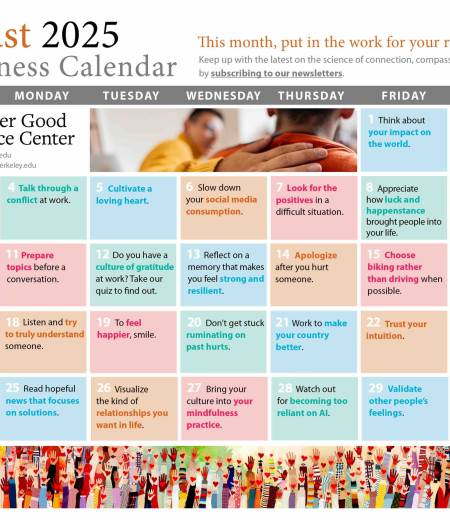It’s back-to-school season, and if you have a teen or even know one, they’re probably feeling a little anxious. New class schedule, new classmates, new expectations. These days, when anxious teens turn to us as parents, teachers, and coaches for help, we might encourage “mindfulness,” or paying attention to the present moment with openness and without judgment.
But the truth is, developmentally, this inner development method might not always be the healthiest approach. While mindfulness advice is well-intentioned, it’s also often misapplied, and it cannot exist on its own. At this phase, teens’ anxiety often centers around their fragile, emerging relationships, which, in turn, give meaning to the self.
That’s why mindfulness, which too often focuses exclusively on the self, tends to miss the relationship work teens so desperately need. It’s OK, but it’s not enough. Our own research suggests that taking a compassion-based approach during the transition to early adolescence has real benefits.
X

SEE Learning is a comprehensive, compassion-based educational framework developed at Emory University that integrates social-emotional learning with ethical discernment, resilience, and systems thinking. It equips students and educators with tools to cultivate awareness, empathy, and responsible action for personal and collective well-being
In our study of over 600 students between the ages of nine and 11, those who participated in SEE Learning showed measurable gains in perspective taking, empathic concern, Self-compassion, and intrinsic prosocial motivation to help others. They also reported stronger academic goal setting and a greater sense of classroom support.
Ideally, mindfulness would be combined with compassion training that helps teens learn to nurture and protect their ties to one another.
Why mindfulness doesn’t (always) work
When we tell teens to “just breathe” in the face of relational pain, it can feel dismissive. Perhaps worse, doing so can make them feel even more alone. And when mindfulness is delivered as a sit-and-be-quiet tool to reduce stress, it loses its power to heal.
While evidence has demonstrated the promise of mindfulness in teens, it’s not always taught in a developmentally appropriate way, especially for adolescents. A 2024 analysis by Brian Galla and his colleagues found that, in general, universal school-based mindfulness programs had no lasting benefits for adolescents.
Why? It may be because these programs often bypass what teens are actually working on: identity development, social connection, and meaning making. Mindfulness, when stripped of its context, can feel like a solitary act.
We aren’t calling for a rejection of mindfulness altogether. In fact, teens have told our research team that they’re curious to learn more about mindfulness, but they want more than strategies for individual coping.
They’re not just asking to feel calm, they’re asking to feel seen. They want to understand themselves, their relationships, and their place in the world.
Therefore, we need to invest in practices that build relationships, foster belonging, and meet teens where they are.
What mindfulness misses
Beneath the surface-level jitters of back-to-school season lies a deeper, more vulnerable fear for teens: Do people see me? In other words, underneath “Will math be too hard?” might be:
- “Will people notice me?” Among crowded classrooms and social media feeds, teens want to know that their presence means something and that they are not replaceable or irrelevant.
- “Am I good enough, or do I have to change to fit in?” Teens are constantly navigating other people’s expectations, whether they be around academic standing, social status, or even personal identity.
- “Do you actually like me, or are you just tolerating me?” Teens are hyper-aware of social cues, especially ones that feel challenging to their sense of authenticity and belonging.
These questions aren’t new. Developmental scientists have been exploring the roots of these human fears and longings for decades. Writers like Toni Morrison and Maya Angelou have long understood that how we are seen, cared for, and valued by others shapes our sense of self. And from our own vantage point as teachers and scientists who have teens in our lives whom we love, we know these questions are not abstract. They are real experiences that show up in classrooms, at dinner tables, and in quiet moments of self-doubt.
We can help on a deeper, relational level. That’s where compassion training comes in.
Meeting teens where they are
Young people are wired for relationships, and emerging research shows that adolescents thrive when given concrete, relationship-oriented strategies to navigate their complex social worlds. In this context, compassion becomes an essential area of study and practice—not just a virtue, but a skill that can be cultivated.
Compassion, here, means empathy plus action. It goes beyond simply noticing or calming; it involves recognizing suffering, whether in oneself or others, and responding with thoughtful, discerning action to help. This makes compassion distinct from mindfulness, which emphasizes present-moment awareness without necessarily prompting a response.
Compassion, by contrast, is awareness in action. It’s a dynamic, context-sensitive process that adolescents can learn, practice, and embody in their daily lives. With guidance and support, teens can develop compassionate habits that strengthen their relationships, Emotional resilience, and sense of purpose.
Compassion enters a child’s life through many channels, family bonds, friendships, cultural traditions, and spiritual teachings. It’s not confined to the classroom; it’s part of what makes us human. And while compassion may arise naturally, research increasingly finds it can also be cultivated in ways that strengthen resilience and enhance life quality. For adolescents, who are navigating identity, belonging, and emotional complexity, harnessing this human capacity may be especially powerful. Compassion-based practices can be used by teachers and parents to help answer the developmental questions of belonging that teens are inherently asking. And as one of us (Blake Colaianne) demonstrated in a 2025 study, compassion practices can be taught to teens in ways that feel accessible, relevant, and meaningful.
If we want to support teens’ Mental health and resilience, we need to move beyond mindfulness as a standalone solution and, instead, reframe it through a compassion-based, relational lens. When we intertwine mindfulness and compassion, we shift away from simply telling teens to “pause and breathe” to manage stress and, instead, acknowledge the human needs that evoked the stress to begin with. In fact, if we start with “I see you, and what you say matters,” we might find that pausing and breathing becomes even easier. The fundamental difference is that mindfulness can protect and nurture the self, but what teens need are strategies to protect and nurture their social ties, the relationships that give them meaning.
School-based programs like SEE Learning are showing what’s possible in compassion education. As a research leader in social-emotional and ethical learning, I’ve helped guide SEE Learning research across multiple countries, including high-conflict contexts like Ukraine.
In my 2025 study, we found that compassion-centered approaches improved empathy, motivation, and classroom climate among elementary students. And in a separate qualitative study in Ukraine, teachers described SEE Learning as essential for helping students process trauma and build Emotional resilience during wartime. These findings underscore the global relevance of compassion-based education, not just as a curriculum, but as a humanizing force in schools.
What you can do
As compassion scientists, we’ve found that there are evidence-based tools that can support teens in ways that standalone mindfulness cannot. These tools help teens feel seen, valued, and connected…because, developmentally, that’s what they need most.
While you may not be able to put your teen (or students) through a formal compassion training program, there are certain principles that can be adapted to any setting, at home or school.
- Secure the base: Discuss with your teen, “Who is rooting for you?” or “Who or what reminds you of who you are?” Help them build a photo album or playlist on their phone that can remind them of their worth and what they are capable of.
- Practice ethical reflection: Use real-life scenarios and structured dialogue to help teens explore multiple perspectives and build the confidence to do what’s right, even when it’s hard. While we work to “see” teens, we can also help them “see” each other.
- Co-create: View teens as experts in what teens are currently going through. Enlist their help to design compassion tools for younger students in school. (Research shows that this not only helps others but also deepens their own empathy.)
- Let them lead: Support teens in designing and leading projects that apply care and compassion to life outside of school, such as real-world challenges in their communities. Center project-based learning around the ethics of care.
As we prepare for the back-to-school season, let’s carry forward this wisdom: Our presence and our care are the things that shape a teen’s sense of self and help them feel safe enough to take risks and grow.













